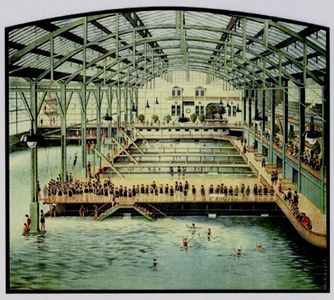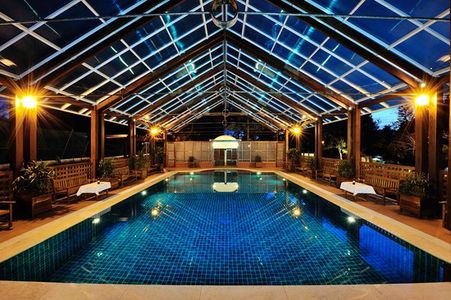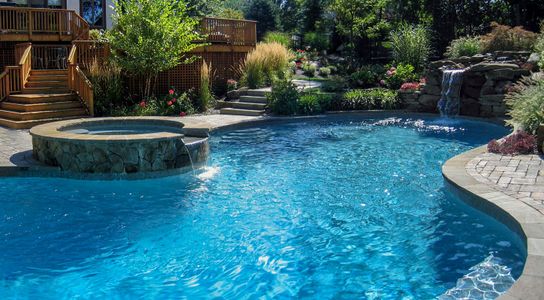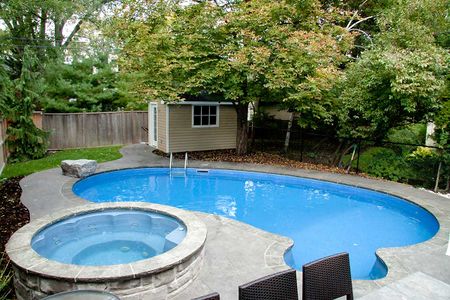Pool
A swimming pool (or just pool for short) is an artificially enclosed body of water intended for swimming or water-based recreation. There are many standard sizes; the largest and deepest is the Olympic size. A pool can be built either above or in the ground, and from materials such as metal, plastic or concrete. Pools are also found as both open air outdoors and enclosed indoors.
Typical equipment
Most pools will have step access to the shallow end of the pool, as well as ladder access at the deep end. Some pools might be equipped with a diving platform of some type. The pool area is normally furnished with deck chairs and places to keep towels dry.
Many pools with have a convenient restrooms and changing rooms designed to handle wet swimmers and possibly a shower to remove pool chlorine.
Not uncommon will be floatation aids and toys, removable floating ropes for creating pool lanes, and possibly a small water slide.
- Use of the pool without permission.
- Use of the pool out of permitted hours.
- Splashing non-swimmers.
- Running by the pool.
- Swimming in forbidden areas (deep end for younger children).
- Throwing/pushing someone into the pool.
- Forbidden types of play.
- Being too noisy.
- Forbidden skinny-dipping.
- Molesting other pool users.
Such offenses are occasionally featured in child spanking fiction. The pool setting invites further variants such as spanking clad only in (wet) swimwear, an easily bared bottom, and a wet bottom spanking.
- Swimming pools
Wadding pools
Wadding pools, or kiddie pools as they are sometimes called, are small shallow pools, for young children to walk and play in the water despite not being able to swim. Typically the small portable above ground pools, though many public pool that cater to families will also have larger more permanent versions.
Private pools
Private pools are either built into a private building, or in backyard of private properties. Typically used for private recreation or exercise, or for a venue of a pool party.
School pools
School pools function as a "classroom" where a PE class can teach students to swim and other water based exercises. As such school pools tend to be medium to large in area size, but might not be particularly deep, especially those belonging to a primary school. The pool is most likely divided into swimming lanes. Depending on school policy, there may be times when the pool is open for recreational purpose either to students or possibly the local community.
Community pools
A community pool is a quasi public pool, reserved for the use of a limited community, such as an apartment complex, a gated community, or a hotel. Most are destined for recreational use, but some might be equipped for excerise as well. But unlike a private pool, they are more likely have strict formal usage rules to keep the majority of the community happy.
Public pools
A public pool might be owned and run either by the local government or by a private organization, but either way they are designed for the use of the general public. Public pools are the most likely to meet Olympic size needs, and normally have both swimming lanes for exercise or training, and also open unlaned areas for recreational use. Medium sized locations might even have a large waterside or two.
Larger, multi-pooled, and multi-slide locations are some times called water parks.
Sanitation
Swimming pool water must be maintained at low levels of bacteria and viruses to prevent the spread of diseases and pathogens between users. Bacteria, algae and insect larvae can also enter the pool without help from swimmers, and cause disease to swimmers and other people in the area.
Pumps and mechanical filters are often used to filter such pathogens out of the water. Chemical disinfectants, such as hypochlorous acid, sodium hypochlorite (household bleach), bromine, salt or mineral sanitizers, are used to make the water inhospitable to pathogens. These substances also turn the water into a faded blue/green color. Chlorine reacting with urea in urine from bathers can create nitrogen trichloride, which has a teargas-type effect.
Urine-indicator dye
Urine-indicator dye is a fictional substance thought to form some sort of colored cloud in a pool to indicate the presence of urine. It's commonly believed to exist in the United States, Canada, and Spain amongst other countries. Experts on such matters say although a reliable dye could be produced, the trick would be getting it to react only to urine and not trigger in the presence of similar organic compounds likely present in swimming pools. It's not a compound anyone appears to be working on either, and understandably so.
However, the substance can be found through pop culture over quite a lengthy time period. In Barbara Leaming's 1985 Orson Welles - A Biography, Orson Welles and his friend Charlie MacArthur would play practical jokes on their friends by using a chemical that caused raspberry-colored clouds to billow in the water around the guilty swimmers. This was intended to be around 1937. Also, in an episode of Nickelodeon's The Adventures of Pete & Pete ("Splashdown"), a chemical called "Wee-Wee See" is used to catch a pool-peeing perpetrator. It won't display the ph color.
Chat rooms • What links here • Copyright info • Contact information • Category:Root



